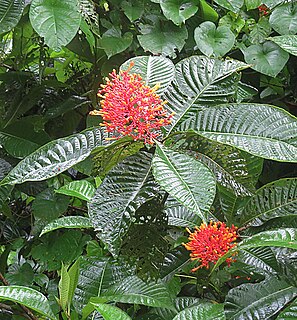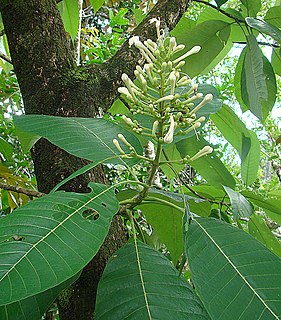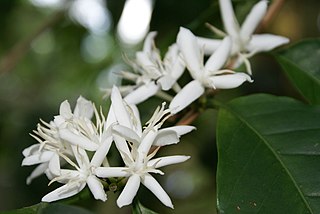
The Rubiaceae are a family of flowering plants, commonly known as the coffee, madder, or bedstraw family. It consists of terrestrial trees, shrubs, lianas, or herbs that are recognizable by simple, opposite leaves with interpetiolar stipules and sympetalous actinomorphic flowers. The family contains about 13,500 species in about 620 genera, which makes it the fourth-largest angiosperm family. Rubiaceae has a cosmopolitan distribution; however, the largest species diversity is concentrated in the tropics and subtropics. Economically important species include Coffea, the source of coffee, Cinchona, the source of the antimalarial alkaloid quinine, some dye plants, and ornamental cultivars.

Arachnothryx is a genus of flowering plants in the family Rubiaceae. It contains about 107 species. It is found from Mexico to Peru and in Trinidad.
Blepharidium is a monotypic genus of flowering plants in the family Rubiaceae. The genus contains only one species, viz. Blepharidium guatemalense, which is native to Guatemala, Honduras and southern Mexico. Older works might mention two species.
Machaonia is a genus of flowering plants in the family Rubiaceae. It has about 32 species. All are indigenous to the neotropics. None has a unique common name. Some species have been called "alfilerillo", a Spanish name for the common and well-known genus Erodium. The type species for Machaonia is Machaonia acuminata.

Isertia is a genus of flowering plants in the family Rubiaceae. It contains 15 species of shrubs or small trees that are indigenous to the neotropics. A few are cultivated as ornamentals.

Hillia is a genus of flowering plants in the family Rubiaceae. It has 24 species. All are indigenous to tropical America.
Cosmocalyx is a monotypic genus of flowering plants in the family Rubiaceae. The genus contains only one species, viz. Cosmocalyx spectabilis, which is found in Mexico, Belize, and Guatemala.

Naucleeae is a tribe of flowering plants in the family Rubiaceae and contains about 183 species in 24 genera. Species belonging to Naucleeae occur from Australasia, tropical Asia, Madagascar, tropical Africa, and to the Neotropics and North America.

The Cinchoneae are a tribe of flowering plants in the family Rubiaceae containing about 125 species in 9 genera. Representatives are found from Costa Rica to southern tropical America. Species within Cinchoneae are characterized as small trees or shrubs with imbricate or valvate corolla aestivation and often dry capsular fruits. Many species contain alkaloids.

Guettardeae is a tribe of flowering plants in the family Rubiaceae and contains about 748 species in 14 genera. Its representatives are widespread geographically and are found in the tropics and subtropics.

Hamelieae is a tribe of flowering plants in the family Rubiaceae and contains about 171 species in 6 genera. Its representatives are found in tropical and subtropical America. The sister tribe Hillieae is sometimes here included.

Hymenodictyeae is a tribe of flowering plants in the family Rubiaceae and contains about 25 species in two genera. The representatives of the genus Hymenodictyon are found in tropical and southern Africa, Madagascar, to tropical Asia and China (Yunnan). The two species of Paracorynanthe are restricted to Madagascar.

Isertieae is a tribe of flowering plants in the family Rubiaceae and contains about 16 species in 2 genera. Its representatives are found in tropical America.

Rondeletieae is a tribe of flowering plants in the family Rubiaceae and contains about 178 species in 8 genera. Its representatives are found from southern Mexico to northern South America and in the Caribbean.

Coffeeae is a tribe of flowering plants in the family Rubiaceae and contains about 303 species in 11 genera. Its representatives are found in tropical and southern Africa, Madagascar, the western Indian Ocean, tropical and subtropical Asia, and Queensland.
Sipaneeae is a tribe of flowering plants in the family Rubiaceae and contains about 43 species in 10 genera. Its representatives are found from Central to Southern Tropical America.
Henriquezieae is a tribe of flowering plants in the family Rubiaceae and contains 20 species in 3 genera. Its representatives are found in northern South America.
Urophylleae is a tribe of flowering plants in the family Rubiaceae and contains 237 species in 6 genera. Its representatives are found in the tropics.

Coussareeae is a tribe of flowering plants in the family Rubiaceae and contains 407 species in 10 genera. The former tribe Coccocypseleae Bremek., consisting of Coccocypselum, Declieuxia, and Hindsia, is considered part of Coussareeae. Its representatives are found in Central and South America.
Palicoureeae is a tribe of flowering plants in the family Rubiaceae and contains about 817 species in 11 genera. Its representatives are found in the tropics and subtropics.












